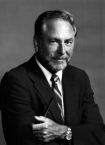Dr. Trevor Colbourn - UCF President (1978-89) - Class of 2008
 It is widely known that today's football program began as a promise made by Dr. Trevor Colbourn during his inauguration speech as UCF's second President in 1978. Before the football program took shape, Colbourn led another landmark effort that greatly affected the athletics department. In his broad national vision for his new school, he sought an official name change that led the switch from Florida Technological University to the University of Central Florida. Starting fall, 1979, the first UCF Knights began taking the field.
It is widely known that today's football program began as a promise made by Dr. Trevor Colbourn during his inauguration speech as UCF's second President in 1978. Before the football program took shape, Colbourn led another landmark effort that greatly affected the athletics department. In his broad national vision for his new school, he sought an official name change that led the switch from Florida Technological University to the University of Central Florida. Starting fall, 1979, the first UCF Knights began taking the field.
From day one, Colbourn lobbied for a football program, which he thought would `put UCF on the map'. He felt having a football team was the key to opening the door for visibility of the University as a whole. He was a driving force behind the inaugural 1979 season, and the great effort it took to make it happen so soon into his tenure.
Helping to overcoming several operational challenges during the sport's first decade, Colbourn remained close to the football program and continued to support it through its growth from Division III to Division II and ultimately into Division I-AA (now Football Championship Subdivision) shortly after his retirement. Befitting, the team did have a winning record the final three seasons of his presidency - the first winning seasons since the 6-2 inaugural mark.
Colbourn's sense of growth extended beyond the football program, approving the school's move from Division II to Division I in all other sports in 1984-85. At the Division II level, UCF was a dominant program winning and competing for national titles in several sports. However, Colbourn knew that competing at the highest NCAA level was the only class good enough for his vision for the University. Among the new sports that were added during Colbourn's tenure were women's tennis and women's soccer, which immediately was among the nation's elite with star player Michelle Akers. Befitting of his retirement, the baseball program, which also saw a rough transition at the onset qualified for its first Division I NCAA Regional in spring, 1989.
So much advancement would take place at UCF during Colbourn's term as President. Enrollment increased sixty percent to more than 18,000 students. Colbourn would also establish the College of Arts and Sciences, the Undergraduate Studies Office, the Honors Program, several stand alone doctoral programs, as well as expanding the undergraduate and graduate school program offerings.
The campus increased in size with the building of the Wayne Densch Sports Center (located on the south side of campus), the establishment of the Greek Park, library expansion, growth in residential housing, and the construction of new buildings for the Fine Arts (later renamed Colbourn Hall) and the Colleges of Business Administration and Engineering. Additionally, the Arena, the Student Union and the Barbara Ying Center went into planning.
H. Trevor Colbourn was born in Armidale, New South Wales, Australia, and moved to England as a child. Colbourn earned his B.A. at the University of London then moved to the U.S. in 1948 to further his education at the College of William and Mary; finally earning his Ph.D. in American History at Johns Hopkins in 1953. In 1949, Colbourn married the former Beryl Evans and they eventually had two daughters.
Colbourn taught at Penn State and Indiana University in Bloomington before moving into administration. In 1967, he became Graduate Dean at the University of New Hampshire. In 1973 he was appointed Academic Vice President of San Diego State University and eventually served as Acting President from 1977-1978 before becoming President of FTU in 1978.
After retiring as president, Colbourn returned to teaching history full-time at the university. In 1990, he earned the title President Emeritus and assumed the role of University Historian in 1991. As part of the latter appointment, he compiled an oral history of the university. He was an expert on the American Revolution and Thomas Jefferson. Colbourn penned a number of books and articles, including "The Lamp of Experience," "Fame and the Founding Father," and "The Americans: A Brief History."
